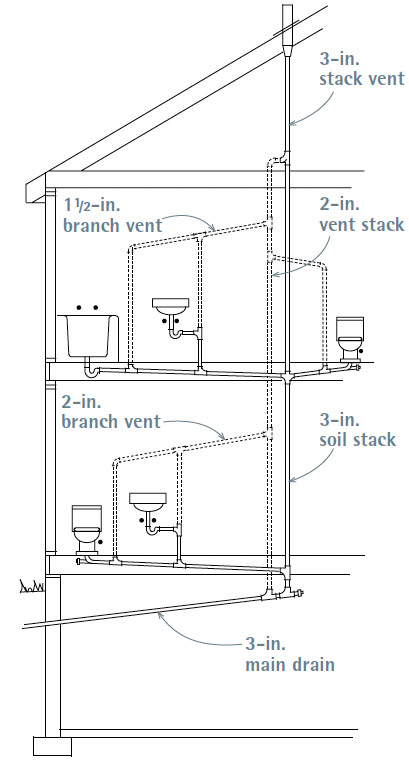Grasping The Importance of Proper Ventilation in Plumbing Systems
Grasping The Importance of Proper Ventilation in Plumbing Systems
Blog Article
They are making a number of great pointers relating to Essential Plumbing Vent Pipes: Understanding Their Role as a whole in the article beneath.

Correct ventilation in plumbing systems is frequently forgotten, yet it is important for keeping the functionality and security of your home's plumbing. Air flow aids regulate atmospheric pressure, avoid the accumulation of unsafe gases, and guarantee the effective elimination of waste. In this overview, we will discover the relevance of correct pipes ventilation, just how it works, and the benefits it offers your pipes system.
Exactly How Ventilation Works in Plumbing Solutions
Air Pressure Guideline
Appropriate air flow keeps well balanced atmospheric pressure within the plumbing system. When water streams with pipes, it displaces air. Without appropriate air flow, this displacement can produce unfavorable pressure, resulting in slow down drains or siphoning of water from catches, which can cause undesirable odors to permeate right into the home.
Stopping Drain Gas Accumulation
One of one of the most essential functions of pipes vents is to prevent drain gases, such as methane and hydrogen sulfide, from accumulating within the home. These gases can position serious health dangers and are very combustible. Vent pipes enable these gases to escape safely outside.
Helping in Waste Elimination
Air flow aids in the effective removal of wastewater by protecting against airlocks in the drain system. When air can stream openly through the vents, it allows water and waste to stream smoothly through the pipes, lowering the threat of obstructions and backups.
Benefits of Proper Air Flow
Improved System Efficiency
Appropriately aerated pipes systems operate much more efficiently, with less obstructions, faster draining pipes, and less strain on the pipelines. This efficiency prolongs the lifespan of the pipes system.
Improved Air High Quality
By avoiding sewage system gases from entering your home, correct air flow adds to much better indoor air high quality, making your living atmosphere healthier and a lot more comfy.
Avoiding Water Damage
Ample ventilation helps protect against water from being siphoned out of catches, which can lead to sewer gases entering the home and causing water damages with time.
Actions to Make Certain Correct Ventilation
Consulting Plumbing Codes
Constantly get in touch with regional pipes codes when designing or modifying your pipes system. These codes provide the needed standards for appropriate airing vent and ensure your system meets security standards.
Regular Inspection and Upkeep
Routine evaluations can aid determine potential air flow issues before they become significant issues. Upkeep tasks, such as cleaning up vent pipes and looking for blockages, are crucial for keeping the system in good working order.
Professional Setup
For new setups or significant alterations, it's important to hire an expert plumber. They have the know-how to make sure the air flow system is properly designed and installed according to code.
Understanding Ventilation in Pipes
Air flow in plumbing refers to the network of pipelines that enable air to flow via the water drainage system. These vents serve several functions, including managing air pressure within the pipes, protecting against sewer gases from getting in the home, and helping in the smooth circulation of wastewater.
Kinds Of Pipes Vents
Main Heap Vent
The main stack vent, likewise known as the vent stack, is the key air vent in a pipes system. It extends from the main drain line up via the roofing system, enabling gases to get away and fresh air to go into the system.
Branch Vent
Branch vents link to the major pile vent and offer private components, such as sinks, bathrooms, and showers. These vents make sure that each fixture has sufficient ventilation to function properly.
Air Admittance Valve (AAV).
An Air Admittance Valve (AAV) is a one-way shutoff that allows air to enter the plumbing system without the demand for a standard air vent pipeline prolonging with the roofing. AAVs are generally made use of in improvements or areas where installing a standard air vent is unwise.
Signs of Poor Ventilation in Plumbing.
Slow Draining Fixtures.
If your sinks, tubs, or toilets are draining slowly, maybe an indicator of bad ventilation. Inadequate air flow can produce a vacuum cleaner effect, making it hard for water to drain pipes effectively.
Gurgling Seems.
Gurgling audios originating from drains are usually a result of air being sucked with water catches as a result of negative pressure in the pipelines. This is a clear indication of not enough air flow.
Unpleasant Smells.
Sewer odors inside your home are a red flag that your pipes system is not properly ventilated. This can indicate that sewage system gases are not being effectively aired vent outside, causing potentially harmful conditions.
Common Ventilation Blunders.
Poor Vent Sizing.
Utilizing undersized vent pipelines can result in inadequate air flow and stress imbalances in the system. It's important to utilize vents that satisfy the specific demands of your plumbing system.
Improper Vent Placement.
Putting vents as well much from the components they offer can lower their effectiveness. Appropriate positioning makes certain that air can stream freely and effectively via the system.
Ignoring Code Needs.
Building regulations provide details standards for plumbing ventilation. Overlooking these codes can lead to a system that falls short to function correctly and might cause costly repair work or carcinogen.
Verdict.
Correct air flow is a crucial component of any plumbing system, making sure that it functions efficiently and securely. By recognizing the value of ventilation, acknowledging the indications of inadequate ventilation, and taking steps to keep your system, you can stop costly concerns and secure your home's air high quality.
4 Things You Should Know About Your Plumbing Vents
What Plumbing Vents Are
Also called a vent stack, a plumbing vent is a vertical pipe attached to your drain line that runs through your roof. The plumbing vent pipe, or plumbing air vent, removes gas and odors from your plumbing system and allows fresh air to enter the pipes, helping the water to flow out of the drain pipes.
What Plumbing Vents Do
Plumbing vents have two basic functions. One of which is to allow unpleasant smelling wastewater and sewer gasses to escape your plumbing system instead of entering your home. Plumbing vent pipes are typically located on roofs, away from windows, to ensure the fumes exit the home completely.
The other function of the plumbing vent is to move fresh air into your plumbing system. This helps move water through every plumbing fixture in your house, like toilets and sink drains. Think of the way in which you need to let a little air into the bottle as you pour soda in order to make the drink flow smoothly.
Different Types of Plumbing Vents
True vent: This is the most common vent option. In simplest terms, a true vent is a vertical pipe attached to your drain line that exits through the roof. They often function as the main vent that other fixtures can connect to. Re-vent pipe or auxiliary vent: Attached to the drain line near specific plumbing fixtures, re-vent pipes run up and over to connect to the main vent. Common vent: Two plumbing fixtures installed on opposite sides of a wall are typically tied into the vent stack using something known as a sanitary cross. Wet vent: This venting option operates as a drain pipe and a vent at the same time. Wet vent drainage systems drain water from one fixture while venting the air from another. Although they’ve been used for over 100 years, wet vent systems have only recently been added to the plumbing code in many areas. If you’re planning on installing one in a bathroom remodel, make sure you check your local code prior to construction. Loop vent: For free-standing fixtures like kitchen island sinks, loop vents are ideal. These vent pipes run under the floor, rise from the P-trap, and create a loop inside the cabinet sink. Air admittance valve: An AAV is a one-way mechanical valve typically installed at the site of the plumbing fixture. AAVs allow venting to occur without having to tie into a larger venting system. They’re ideal for venting fixtures where you aren’t able to easily connect to an existing vent system. Common Plumbing Vent Issues
Although vent pipes typically don’t have water flowing through them, they’re still subject to many typical plumbing issues. For example, clogs are one of the most common problems associated with sewer vent pipes. If your vent pipe gets clogged, all of your plumbing fixtures tied into the vent stack will be affected.
A sink with a slow drain that bubbles and gurgles or a strong sewage smell around your toilet are both indicators that your toilet vent pipe is clogged. Because most vent pipes exit through the roof, old leaves, twigs or even a bird’s nest could be clogging the pipe.
Clogs in your vent pipe system cause a buildup of negative pressure, meaning that water won’t be able to flow out of your home very well. It’s similar to putting your finger over the opening of a straw to trap water inside. When you remove your finger, the water is able to flow out of the straw.
If you suspect you have any blockage in your vent, make sure you have a professional come examine the situation. Left unchecked, a blocked air vent can lead to other costly repairs, like leaks and sediment buildup.
Under Pressure
Pipe vents are essential aspects of a home’s plumbing system. Owning a home means learning about all sorts of things you never put much thought into before. But by understanding as much as you can about the important systems of your home, you can keep those budgets intact and those anxiety levels low.
https://www.homeserve.com/en-us/blog/home-improvement/plumbing-vents/

Do you like reading about Why Plumbing Air Vents Are Important? Give a remark down the page. We would be pleased to hear your thinking about this entry. We hope that you visit us again in the near future. Do you know about anybody else who is involved in Essential Plumbing Vent Pipes: Understanding Their Role? Why not share it. I am grateful for your time. Don't hesitate to stop by our blog back soon.
Call Today Report this page